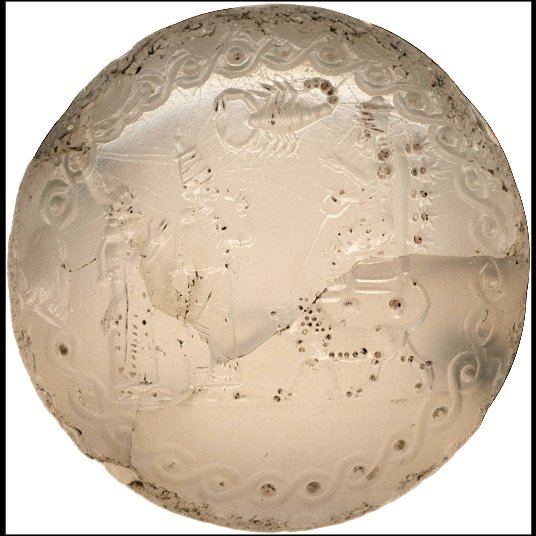In ancient Mesopotamia seals were used to leave impressions on clay. They could be applied to a lump of clay on a string wrapped around a papyrus document, ensuring no one could open it without breaking the seal (called a bulla).
They could also be applied to cuneiform tablets.
They could also be applied to cuneiform tablets.
When cuneiform tablets were sealed, the seal meant something equivalent to a modern-day signature.
When you sign a check or a contract, you are formally authorizing that transaction. Same with a seal.
When you sign a check or a contract, you are formally authorizing that transaction. Same with a seal.
Losing your seal could be very bad (ancient identity theft!), which is why seals were often worn as rings or mounted on a string and worn around the neck.
Incidentally, in the Song of Solomon 8:6 the woman asks the man to "place me like a seal over your heart, like a seal on your arm; for love is as strong as death, its jealousy unyielding as the grave."
The intensity of guarding their love is compared to the intensity of guarding one's personal seal.
In Assyria seals could be associated with governmental offices, not just individuals.
The king's seal showed the king fighting a lion, a scene familiar from Assyrian sculpture.
In Assyria seals could be associated with governmental offices, not just individuals.
The king's seal showed the king fighting a lion, a scene familiar from Assyrian sculpture.
(Source for the above: https://blog.britishmuseum.org/introducing-the-assyrians/)
All Assyrian kings used this seal, and officials empowered to act on the king's behalf had their own copies. This seal was used to authenticate royal orders, and lack of a seal could lead one to question if the orders were genuine.
All Assyrian kings used this seal, and officials empowered to act on the king's behalf had their own copies. This seal was used to authenticate royal orders, and lack of a seal could lead one to question if the orders were genuine.
For example, when an official tried to get Nabû-ushallim, the Babylonian leader of the Bit-Dakkuri tribe to turn over fugitives, Nabû-ushallim told that official to buzz off until he came back with a properly signed order.
(Source: http://oracc.museum.upenn.edu/saao/P237840 )
(Source: http://oracc.museum.upenn.edu/saao/P237840 )
The point being, seals were valuable. Having a department seal was valuable - it allowed you to control how orders were issued in your name and to control the movement of goods.
It took scholars longer to recognize, but the office of the queen had its own seals.
It took scholars longer to recognize, but the office of the queen had its own seals.
Instead of a lion, the queen's symbol was a scorpion.
This seal belonged to Sennacherib's queen Tashmetum-Sharrat, who reigned in the 680s BC.
This was a personal seal. Note the king and queen standing together before a goddess.
(Source: https://www.britishmuseum.org/collection/object/W_2002-0515-1)
This seal belonged to Sennacherib's queen Tashmetum-Sharrat, who reigned in the 680s BC.
This was a personal seal. Note the king and queen standing together before a goddess.
(Source: https://www.britishmuseum.org/collection/object/W_2002-0515-1)
But note there is a scorpion above the figures.
That scorpion appears elsewhere.
On the left is a tag concerning the movement of textiles.
Assyrian queens oversaw the production of high quality textiles in the palaces, an enterprise carried out by hundreds of weavers.
That scorpion appears elsewhere.
On the left is a tag concerning the movement of textiles.
Assyrian queens oversaw the production of high quality textiles in the palaces, an enterprise carried out by hundreds of weavers.
It's also possible that the queen had her own chariot unit, as persons with the title "chariot driver of the queen" or "officer of the queen" show up as witnesses in legal documents.
But why a scorpion?
But why a scorpion?
Karen Radner notes a similarity between the Akkadian word for nurse (tārītu, derived from the verb tarû, meaning 'to raise up') and the word for a female scorpion (tārīt zuqaqīpi, 'the nurse of scorpions')
Female scorpions give birth to live young.
The young are soft and vulnerable. They climb on their mother's back, where she fiercely protects them until they are old enough to set out on their own.
The young are soft and vulnerable. They climb on their mother's back, where she fiercely protects them until they are old enough to set out on their own.
And what was the most important duty of an Assyrian queen?
Giving birth to and raising an heir to the throne.
We think of scorpions as dangerous and terrifying, but the Assyrians understood them foremost as a creature fiercely protective of its offspring.
Giving birth to and raising an heir to the throne.
We think of scorpions as dangerous and terrifying, but the Assyrians understood them foremost as a creature fiercely protective of its offspring.
This theme of protection appears in other iconography of Assyrian queens.
Let's zoom in on that seal above:
The queen appears to be wearing something called a "Mural crown" which is a fancy way of saying she's wearing a model of a castle on her head.
Let's zoom in on that seal above:
The queen appears to be wearing something called a "Mural crown" which is a fancy way of saying she's wearing a model of a castle on her head.
Assyrian queens were commonly depicted wearing mural crowns.
Kings don't wear them.
What does a wall signify? Protection. Protection of a capital city, the seat of a dynasty. And a dynasty cannot continue without its queens.
Kings don't wear them.
What does a wall signify? Protection. Protection of a capital city, the seat of a dynasty. And a dynasty cannot continue without its queens.

 Read on Twitter
Read on Twitter















